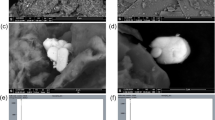Summary
The elemental compositions of chloragosome ‘granules’ in the earthworm Lumbricus rubellus living in non-polluted (Dinas Powys) and heavily Pb-polluted (Wemyss) soils were determined by fully quantitative electron probe X-ray microanalysis. P, Ca, S and Zn were the major elemental components of the chloragosomes. High Pb concentrations were found in chloragosomes of Wemyss animals; Pb was not detected in chloragosomes of Dinas Powys animals. Partial correlation and regression analysis indicated that the in vivo accumulation of Pb by chloragosomes was accompanied by diminished chloragosomal Ca concentrations. Pb is bound by P-containing ligand(s) in the chloragosome matrix. The sequestration of Pb by chloragosomes results in the detoxification of the metal by accumulative immobilization.
Similar content being viewed by others
References
Brown BE (1982) The form and function of metal-containing ‘granules’ in invertebrate tissues. Biol Rev 57:621–667
Fischer E (1977) The function of chloragosomes, the specific agepigment granules of annelids — a review. Exp Gerontol 12:69–74
Fischer E, Trombitás K (1980) X-ray microprobe analysis of chloragosomes of untreated and of EDTA-treated Lumbricus terrestris by using fresh air-dried smears. Acta Histochem 66:237–242
Howard B, Mitchell PCM, Richie A, Simkiss K, Taylor M (1981) The composition of intracellular granules from metal-accumulating cells of the common garden snail (Helix aspersa). Biochem J 194:507–511
Ireland MP (1975) Distribution of lead, zinc and calcium in Dendrobaena rubida (Oligochaeta) living in soil contaminated by base metal mining in Wales. Comp Biochem Physiol 52B:551–555
Ireland MP (1978) Heavy metal binding properties of earthworm chloragosomes. Acta Biol Hung 29:385–394
Ireland MP, Fischer E (1978) Effect of Pb++ on Fe+++ tissue concentrations and delta-aminolaevulinic acid dehydratase activity in Lumbricus terrestris. Acta Biol Hung 29:395–400
Ireland MP, Richards KS (1977) The occurrence and localisation of heavy metals and glycogen in the earthworms Lumbricus rubellus and Dendrobaena rubida from a heavy metal site. Histochemistry 51:153–166
Jamieson BGM (1981) The ultrastructure of the Oligochaeta. Academic Press, London
Morgan AJ (1981) A morphological and electron-microscope study of the inorganic composition of the mineralized secretory products of the calciferous gland and chloragogenous tissue of the earthworm, Lumbricus terrestris L. The distribution of injected strontium. Cell Tissue Res 220:829–844
Morgan AJ (1982) The elemental composition of the chloragosomes of nine species of British earthworm in relation to calciferous gland activity. Comp Biochem Physiol 73A:207–216
Morgan AJ (1984) The localisation of heavy metals in the tissues of terrestrial invertebrates by electron microprobe X-ray analysis. Scanning Electron Microsc 4:1847–1865
Morgan AJ, Morris B (1982) The accumulation and intracellular compartmentation of cadmium, lead, zinc and calcium in two earthworm species (Dendrobaena rubida and Lumbricus rubellus) living in highly contaminated soil. Histochemistry 75:269–285
Morgan AJ, Winters C (1982) The elemental composition of the chloragosomes of two earthworm species (Lumbricus terrestris and Allolobophora longa) determined by electron probe X-ray microanalysis of freeze-dried cryosections. Histochemistry 73:589–598
Morgan AJ, Winters C (1987) The contribution of electron probe X-ray microanalysis (EPXMA) to pollution studies. Scanning Microsc 1:133–157
Morgan AJ, Morris B, James N, Morgan JE, Leyshon K (1986) Heavy metals in terrestrial macroinvertebrates: Species differences within and between trophic levels. Chem Ecol 2:319–334
Morgan JE (1985) The interactions of exogenous and endogenous factors on the accumulation of heavy metals by the earthworm Lumbricus rubellus. In: Lekkas TD (ed) Proceedings of the International Conference of Heavy Metals in the Environment. Athens, Sept., 1985, vol 1. CEP Consultants, Edinburgh, pp 736–738
Morgan JE (1987) The influence of exogenous and endogenous factors on the accumulation of heavy metals by selected earthworm species. Unpublished Ph. D. thesis, University of Wales
Morgan JE, Morgan AJ (1988) Earthworms as biological monitors of cadmium, copper, lead and zinc in metalliferous soils, Environ Pollut 54:123–138
Morgan JE, Morgan AJ (1989) Zinc sequestration by carthworm (Annelida: Oligochaeta) chloragosomes: an in vivo investigation using fully quantitative electron probe X-ray microanalysis. Histochemistry 90:405–411
Nieboer E, Richardson DHS (1980) The replacement of the nondescript term ‘heavy metals’ by a biologically and chemically significant classification of metal ions. Environ Pollut (Series B) 1:3–26
Prentø P (1979) Metals and phosphate in the chloragosomes of Lumbricus terrestris and their possible physiological significance. Cell Tissue Res 196:128–134
Simkiss K (1976) Intracellular and extracellular routes in biomineralization. Symp Soc Exp Biol 30:423–444
Simkiss K (1981) Cellular discriminating processes in metal accumulating cells. J Exp Biol 94:317–327
Tsuchiya K (1979) Lead. In: Friberg L, Nordberg CF, Vouk VB (eds) Handbook on the Toxicology of Metals. Elsevier/North Holland Biomedical Press, Amsterdam, pp 451–484
Winters C, Morgan AJ (1988) Quantitative electron probe X-ray microanalysis (EPXMA) of lead-sequestering organelles in earthworms: technical appraisal of air-dried smears and freezedried cryosections. Scanning Microsc 2:947–958
Author information
Authors and Affiliations
Rights and permissions
About this article
Cite this article
Morgan, J.E., Morgan, A.J. The effect of lead incorporation on the elemental composition of earthworm (Annelida, Oligochaeta) chloragosome granules. Histochemistry 92, 237–241 (1989). https://doi.org/10.1007/BF00500924
Received:
Accepted:
Issue Date:
DOI: https://doi.org/10.1007/BF00500924




